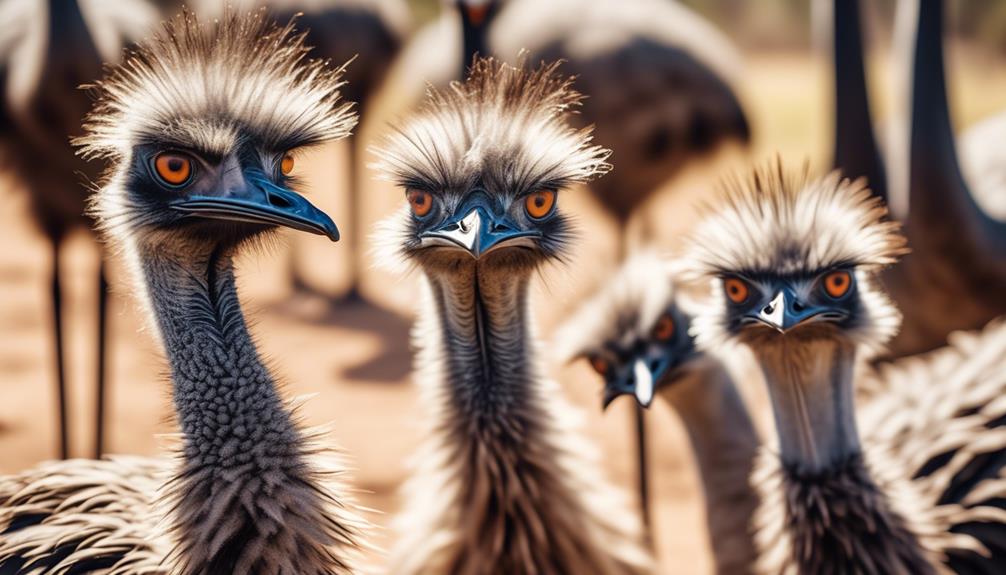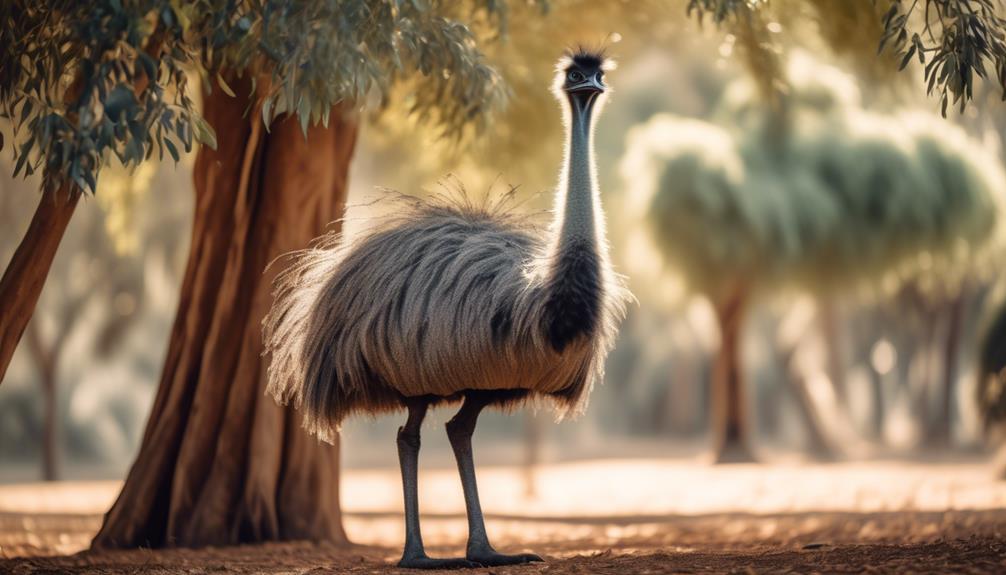
Imagine yourself standing in the vast expanse of a wild, untamed landscape, the sun casting its golden rays upon the rugged terrain. In the distance, you spot a peculiar sight – a group of majestic emus, their long legs propelling them gracefully across the ground.
These enigmatic creatures, with their unique behavior, intriguing diet, and diverse habitats, hold many secrets waiting to be uncovered.
As you delve into the world of emus, you will discover the intricacies of their social dynamics, the fascinating rituals of mating, their varied feeding habits, and the habitats they call home.
Get ready to embark on a captivating journey of discovery, where each turn of the page brings you closer to understanding the captivating world of emus.
Social Dynamics

Social dynamics among emus in the wild are characterized by complex interactions and hierarchical structures. Emus form dominance hierarchies, with individuals establishing their rank through various interactions. The dominant emus have priority access to resources, such as food and mates, while subordinate individuals must yield to the dominant ones.
Communication methods play a crucial role in establishing and maintaining the dominance hierarchy among emus. Emus use a variety of vocalizations, body postures, and displays to convey their intentions and establish dominance. The dominant emus often use low-frequency booming calls, which can be heard over long distances, to assert their dominance and maintain their status within the group. Subordinate emus, on the other hand, may use submissive displays and vocalizations to signal their lower rank and avoid conflicts with higher-ranking individuals.
Observing emus in the wild reveals a fascinating social dynamic where dominance hierarchies are established and maintained through various communication methods. The complex interactions between individuals highlight the importance of effective communication in the emu community. Understanding these social dynamics provides valuable insights into the behavior and interactions of emus in their natural habitat.
Mating Rituals
During the mating season, emus engage in elaborate courtship rituals to attract a mate and establish breeding pairs. These courtship displays are fascinating to observe, as emus employ a variety of behaviors to impress potential partners. Here are three remarkable courtship rituals that highlight the complexity of emu mating:
- Drumming: Male emus produce deep, resonating drumming sounds by vibrating their throat pouches. This rhythmic display not only showcases the male's physical prowess but also serves as a means of communication, signaling their availability and readiness to mate.
- Dancing: Emus engage in an intricate dance routine during courtship. Males stretch out their necks, sway from side to side, and elegantly fan out their feathers. This display of flamboyant movements and vibrant plumage is intended to captivate the attention of females, illustrating the male's vitality and genetic quality.
- Displaying Nests: Male emus take on the responsibility of constructing nests and incubating the eggs. To attract females, males showcase their nest-building skills by meticulously arranging sticks, leaves, and grass. This demonstration of dedication and parental investment signals the male's suitability as a mate and increases his chances of reproductive success.
These courtship displays play a crucial role in determining reproductive success for emus. By engaging in these elaborate rituals, emus establish strong breeding pairs, ensuring the continuation of their species in the wild.
Feeding Habits

Emus exhibit a diverse range of feeding habits, adapting their diet to the availability of food sources in their environment. These large flightless birds are primarily herbivores, but they also consume insects and small vertebrates when necessary. Emus have a unique ability to selectively feed on a variety of plant species, including grasses, shrubs, fruits, and seeds. They use their sharp beaks to pluck and tear vegetation, showing a preference for young shoots and tender leaves.
One significant factor that has influenced emu feeding habits is the impact of human activity, specifically agriculture. As humans cleared land for farming and introduced non-native plant species, emus adapted their diet to include these new food sources. They've been observed foraging in agricultural fields, consuming crops such as wheat, barley, and corn. This behavior has led to conflicts between farmers and emus, as the birds can cause significant damage to crops.
Human intervention has also affected the availability of natural food sources for emus. The destruction of forests and the alteration of ecosystems have resulted in a decrease in the diversity and abundance of plants that emus rely on. These changes have forced emus to adapt their feeding habits and seek alternative food sources, often leading them into closer proximity with human settlements.
Dietary Preferences
One key aspect of emu behavior relates to their dietary preferences. Emus are highly adaptive foragers, capable of thriving in a variety of habitats due to their dietary adaptations.
Here are three fascinating facts about their dietary preferences:
- Wide-ranging palate: Emus have a diverse diet that includes both plant and animal matter. They're known to consume fruits, seeds, flowers, leaves, and even bark. Additionally, they opportunistically feed on insects, spiders, and small vertebrates when available. This versatile diet allows emus to exploit a wide range of food sources, ensuring their survival in different environments.
- Digestive prowess: Emus possess a unique digestive system that aids in the breakdown of tough plant material. They have a specialized gizzard, which acts as a grinding chamber, helping them break down fibrous vegetation into smaller particles. This adaptation enables emus to extract nutrients from vegetation that other animals might find indigestible.
- Water-wise strategies: In arid regions, emus have developed ingenious strategies to obtain water. They can detect underground water sources and use their sharp beaks to dig shallow wells, accessing the precious liquid. This ability to locate and access water sources is essential for their survival in dry environments.
Foraging Techniques

Having explored the dietary preferences of emus, we now turn our attention to their remarkable foraging techniques. Emus employ a variety of strategies to locate and obtain food, showcasing their adaptability and resourcefulness in the wild.
One key foraging strategy employed by emus is their ability to cover large distances while searching for food. They're known to travel long distances in search of preferred food sources, using their strong legs to cover up to 30 miles in a single day. This wide-ranging movement allows them to maximize their chances of finding food in their preferred habitats.
Emus also utilize their keen sense of sight to locate potential food sources. Their eyes are positioned on the sides of their heads, giving them a wide field of vision to detect food from a distance. This visual acuity is especially important when foraging in open areas, where they can spot edible plants, fruits, and seeds.
In addition to their foraging strategies, emus also exhibit certain habitat preferences when searching for food. They tend to favor open grasslands and shrublands, where food sources are abundant and easily accessible. These habitats provide them with a diverse range of plant species to feed on, ensuring a varied and nutritious diet.
Adaptations for Survival
To survive in their natural habitats, emus have developed a range of adaptations that enable them to thrive in various environmental conditions. These adaptations primarily focus on camouflage techniques and predator avoidance, allowing emus to blend into their surroundings and avoid detection from potential threats.
Feather coloration: Emus possess a unique feather pattern that helps them blend seamlessly into their surroundings. The mottled brown coloration of their feathers acts as an effective camouflage, allowing them to disappear among the dense vegetation of their habitat. This adaptation helps emus stay hidden from predators such as dingoes and wedge-tailed eagles.
Running speed and agility: Emus are incredibly fast runners, capable of reaching speeds up to 30 miles per hour. This adaptation allows them to quickly escape from predators, using their long legs and powerful muscles to outmaneuver potential threats. Their agility also helps them navigate through challenging terrains, such as dense forests or open plains, further enhancing their chances of survival.
Alertness and vigilance: Emus have developed a keen sense of awareness, constantly scanning their surroundings for any signs of danger. They possess sharp eyesight and acute hearing, allowing them to detect predators from a considerable distance. This heightened vigilance enables emus to react swiftly to potential threats, increasing their chances of evading predation.
Through these adaptations, emus have successfully evolved to survive in their natural habitats, ensuring their continued existence in the wild.
Preferred Habitats

Emus exhibit a strong preference for a diverse range of habitats, each providing specific resources necessary for their survival and thriving. The preferred habitats of emus are characterized by a variety of environmental factors that influence their population density.
Emus are commonly found in open grasslands, savannas, shrublands, and woodlands. These habitats offer ample food sources, such as grasses, seeds, fruits, and insects, which are essential for the emu's diet. The availability of water is also crucial, as emus require regular access to it for drinking and bathing. Therefore, habitats near water sources, such as rivers, lakes, or wetlands, are particularly favored by emus.
Additionally, the presence of suitable nesting sites is essential for emus to successfully reproduce. Emus construct large, shallow nests on the ground, using materials such as leaves, grass, and twigs. Therefore, habitats with sufficient vegetation cover, such as forests or thickets, provide the necessary shelter and protection for their nests and chicks.
Environmental factors, such as temperature, rainfall patterns, and vegetation structure, also play a significant role in determining emu population density and their preferred habitats. For instance, emus tend to avoid regions with extremely hot or cold temperatures, as these conditions can negatively impact their survival and reproductive success. Moreover, habitats with dense vegetation can hinder their movement and foraging activities, making open grasslands and savannas more favorable.
Understanding the emus' preferred habitats and the environmental factors influencing their distribution is crucial for conservation efforts and ensuring the long-term survival of these unique and fascinating creatures.
Nesting Behavior
The nesting behavior of emus is a fascinating and intricate process that involves careful selection of nest sites and the construction of large, shallow nests on the ground. Emus typically choose nest locations that provide good visibility and protection from predators. They often select areas with tall grasses or shrubs that can provide camouflage and concealment for their nests. Once a suitable location is found, emus begin the process of nest construction.
- Meticulous Preparation: Emus meticulously prepare their nest sites by clearing the area of debris and creating a shallow depression in the ground. They use their strong legs and feet to kick away rocks and sticks, ensuring a clean and safe nesting area.
- Nest Construction: Emus construct their nests using a combination of materials found in their environment. They gather grasses, leaves, and branches, which they carefully arrange in a circular shape to form a nest. The nests are quite large, with an average diameter of around 1.5 meters.
- Incubation Period: After completing the nest, the female emu lays her eggs, usually between 8 and 12 eggs in a single clutch. She then takes on the responsibility of incubating the eggs, which takes approximately 50 to 56 days. During this period, the male emu guards the nest and may occasionally take over incubation duties to allow the female to forage for food.
The nesting behavior of emus showcases their remarkable adaptation to their environment. Their careful selection of nest sites and the construction of their nests demonstrate their commitment to ensuring the survival of their offspring.
Brooding and Parental Care

After meticulously constructing their nests, emus display remarkable brooding and parental care behaviors to ensure the survival of their offspring. During the incubation period, which lasts around 50 to 60 days, both male and female emus take turns incubating the eggs. This shared responsibility showcases the strong bond and cooperation between emu parents.
Emu parents demonstrate a high level of attentiveness and dedication to their eggs. They carefully regulate the temperature and humidity of the nest, using their bodies to provide warmth and moisture. This ensures optimal conditions for the embryos to develop and hatch successfully. Emus are known to adjust their body position and posture to maintain the ideal conditions within the nest, showing their extraordinary parental instincts.
To further protect their eggs, emus construct their nests in well-hidden and camouflaged locations, such as dense vegetation or tall grasses. This helps to minimize the risk of predation and disturbance. The meticulous nest construction process involves the male selecting a suitable site and scraping a shallow depression in the ground. The female then lays the eggs into the nest, and both parents cover them with vegetation and debris to provide additional protection and insulation.
Emus' brooding and parental care behaviors showcase their dedication to ensuring the survival of their offspring. With their shared incubation duties, precise nest construction, and attentive care, emus exemplify the remarkable behaviors observed in the wild. Through their nurturing actions, emu parents create a secure and nurturing environment for their eggs, setting the stage for the successful hatching and growth of their young.
Migration Patterns
What are the migration patterns of emus in the wild? Emus, fascinating creatures that they are, exhibit seasonal movements that play a crucial role in their breeding cycle. Here are three key aspects of their migration patterns that will surely evoke a sense of wonder in you:
- Breeding Season Travel: Emus embark on their journeys during the breeding season, which typically begins in late autumn. They travel to specific breeding grounds, often covering long distances in search of suitable mates and nesting sites. Witnessing these graceful giants traverse vast landscapes is truly awe-inspiring.
- Nurturing the Young: After successful breeding, emus undertake another migration to find ideal locations for rearing their chicks. This journey, undertaken with their brood in tow, showcases their dedication as parents. It's heartwarming to see these protective parents guiding their vulnerable offspring through various habitats.
- Seasonal Adaptation: Emus are adaptable creatures, and their migration patterns reflect this. They move in response to changes in food availability and environmental conditions. By observing their movements, we gain insight into their ability to survive and thrive in different ecosystems, fostering a deeper appreciation for the wonders of nature.
Frequently Asked Questions
How Long Do Emus Live in the Wild?
Emus in the wild have varying lifespans influenced by factors such as predation, disease, and habitat conditions. On average, they live for around 10 to 20 years, but some individuals have been known to survive into their 30s.
What Are the Predators of Emus in Their Natural Habitat?
In their natural habitat, emus face a variety of predators that impact their population dynamics. Understanding the predator-prey dynamics is crucial for studying the behavior, diet, and habitat of these fascinating creatures.
Are Emus Territorial or Do They Live in Social Groups?
Emus in the wild are known for their territorial behavior. They establish and defend their own territories, which often overlap with those of other emus. However, they also live in social groups, especially during the mating season. Emus in the wild are not monogamous.
Can Emus Swim?
Yes, emus can swim. They have adaptations like buoyant feathers and powerful legs that enable them to navigate through water. This ability helps them survive in the wild and escape predators.
How Fast Can Emus Run?
Emus are incredible runners. They can reach speeds of up to 30 miles per hour, making them formidable competitors in races. Their speed and agility make for fascinating interactions with humans.
Conclusion
As you observe the emus in their natural habitat, it's clear that their social dynamics and mating rituals play a crucial role in their survival. Their feeding habits and dietary preferences showcase their adaptability and resourcefulness.
With their unique foraging techniques, they expertly navigate their preferred habitats, creating nests and providing parental care. The emus' migration patterns further emphasize their resilience and ability to conquer vast distances.
In this intricate tapestry of nature, the emus stand tall, a symbol of strength and tenacity.




